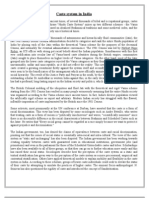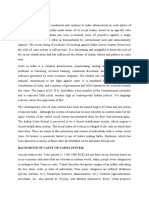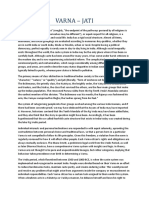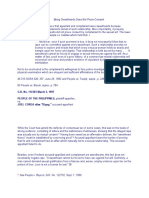An Analysis of Varna & Caste
An Analysis of Varna & Caste
Uploaded by
TheDhruvyadavCopyright:
Available Formats
An Analysis of Varna & Caste
An Analysis of Varna & Caste
Uploaded by
TheDhruvyadavCopyright
Available Formats
Share this document
Did you find this document useful?
Is this content inappropriate?
Copyright:
Available Formats
An Analysis of Varna & Caste
An Analysis of Varna & Caste
Uploaded by
TheDhruvyadavCopyright:
Available Formats
The Varna System and Castes in India
Simply stated, the concept of Varna has led to a severe misunderstanding of castes in India. It gives the world an impression that social stratification is unequivocally hierarchial. This is best disputed by Dipankar Gupta1, who shows that vertical stratification is merely one form of social stratification. There exist differences in society that must be expressed horizontally. To stratify the system based only on the prestige imputed to the castes is extremely rash. According to Hutton, the caste system can be defined along the lines of endogamy, pollution, occupational differentiation, and hierarchy. The Varna system only subsumes the hierarchial organization of caste according to rituals. This vertical arrangement is according to the Purusasukta legendwhere Brahmins come from the head of the primeval being, and Shudras from the feet. There exist other legends (Jati Puranas) that do not place Brahmins on top.2 For example, the Rajputs of Gujarat place themselves on top of the caste hierarchy- above the Brahmins. Therefore, the hierarchization of the caste system according to prestige is flawed ab initio. The Varna system also overlooks the other aspects of caste, which cannot be placed within the same hierarchy as the Varna system dictates. One aspect is occupational differentiation; how are we to quantitatively arrange the occupations linked to various castes? Would it be according to the income each job brings in, or would it be according to the subjective prestige imputed to that occupation? And would this arrangement coincide with that of the Varna arrangement- where the Brahmins are on top? For example, in the Rampura village study, conducted by MN Srinivas, we discover that it is actually the Peasant class (Okkhaligas) that are the most powerful, socioeconomically, even though the Brahmins can be considered to be superior in ritual hierarchy.3 To grasp this passion that India, and the world, have with the caste system we have to understand the origin of caste sensitization. It was an amalgamation of intellectual curiosity and, what some argue, an insidious plot to factionalise Indian society that led to caste sensitization. The first attempt to create a census began in 1769. The official reason for taking a census was its requirement for efficient administration. It was required to measure the population and its growth rate; to ascertain the amount of food needed; to collect taxes; to establish competent judicial and law enforcement bodies; and for the spread of education and public-health centers.4 The purpose for taking a census was founded on a constructive idealwhere it would benefit both the administrators and the inhabitants of India. However, the caste sensitization engendered by the census permanently changed Indian society. To obtain population figures in the North West provinces, the population of the district was represented as a product of the number of villages and number of houses in each village; the average number of people in a house was measured according to the caste that lived in the house. It was Thornton that conceived this methodology, because he believed that upper-caste families
1 2
Social Stratification, edited by Dipankar Gupta, 1993, p. 1 Social Stratification, edited by Dipankar Gupta, 1993, p. 23 3 The Social System of a Mysore village, M.N. Srinivas 4 The Census, Social Structure and Objectification in South Asia , Bernard s. Cohn
Dhruv Yadav, Section D, BA LLB 20131220
The Varna System and Castes in India
were relatively multitudinous than lower-caste ones.5 The caste was inherently linked with the information sought for administrative sources. Christian theorized that caste largely dictates the traditional occupation, and this assumption was used to calculate the population of individuals practicing agriculture as their primary occupation.6 This was, of course, flawed because it was based on the assumption that all persons of a caste practiced the same profession. The population of agriculturists was necessary to ascertain whether a dwelling should be considered a village or a town. It was Bourdillon who propounded the theory of using the population and occupation to consider whether a dwelling was a village or a town. 7 A village was considered a dwelling with a population less than 5000 where the majority practiced agriculture as their primary occupation. It was the recurring deccenial census that inculcated an enduring obsession with the caste system. This obsession was furthered strengthened by the grouping of jatis within a pseudo-varna system. This standardization was used in the 1881 census because of the absence of a uniform system of classification. HH Risleys Ethnographic Survey of Bengal was forced to revert to an alphabetical arrangement of castes after he attempted to organize castes based on social precedence. Risleys system evoked a profusion of critique from all corners of India, with eminent professors stating that such an organization was rash and futile. However, when Risley became commissioner of the 1901 census, his unsubstantiated concept of caste precedence inevitably crept into the census. 8 Hence, it was the census that engendered this caste sensitization, and diffused the varna system throughout India. The Varna system, as it is commonly understood, hierarchizes Hindu society into 4 divisions: the Brahman (priests and scholars), Kshatriya (rulers and soldiers), Vaisya (merchants) and the Shudra (peasants and labourers). Untouchables are left out of the Varna scheme. The Rigveda defines varna as color- referring to the different color of the Aryas and Dasas. Along with distinguishing between Aryas and Dasas, the Rigvedic interpretation of Varna also classified Hindu society into Brahma (priest), Kshatriya (warrior), and vish (common people). It was the Purushasukta hymn which referred to Varna as the 4 orders of society emanating from the different limbs of the Primeval Being (the creator). The Brahmana came from the mouth, the Rajanya (Kshatriya) from the arms, Vaishyas from the thighs, and the shudras from the feet.9 The Varna system had attached precedence to castes and created a hierarchial division of Hindu society. According Professor GS Ghurye, in 1950 there were around 200 castes, which could be further divided into 3000 smaller units which were endogamous, and followed their
5 6
Id. at 4 Id. at 4 7 Id. at 4 8 Id. at 4 9 Varna and Caste , M.N. Srinivas
Dhruv Yadav, Section D, BA LLB 20131220
The Varna System and Castes in India
own unique traditions.10 Therefore the Varna system refers to broad categories of caste and not the true and effective units, and has obfuscated the masses about the reality of the caste system. Subsuming castes into the Varna system overlooks the integral role the untouchables play in Indian society. The Varna system ignores the fact that some castes practice temporary untouchability: even a Brahman woman, while menstruating, can be considered untouchable amongst Brahmans. It seems quite ridiculous that a person may be excluded from the Varna system on a monthly basis. The Varna theory also presumes that all Shudras, which form the largest non-Brahman caste, are the same; but in reality, they have very little in common. The position which a caste occupies in a local hierarchy is different in each locality. Ritual hierarchy is controlled, not only by Varna, but according to the diet, occupation, and customs of a caste. The actual position of a caste in the hierarchy is not purely ritual, but depends on various other factors. The dominance of a caste in a village can also be expressed through dominance in numbers; economic and political power; and more recently, by increasing the educated number of people in the caste.11 This is best highlighted in the Rampura Village case study, by M.N. Srinivas12. Srinivas argues that, in the village of Rampura, the dominant caste is the Okkhaliga (peasant) caste. According to Srinivas, dominance is exhibited when a caste has power over an administrative-judicial body known as the village council (or unofficial panchayat). In Rampura, the Okkhaligas achieved this through having a large population: in a village of 1523 people, nearly half belonged to the Okkhaliga caste. The Okkhaligas gained economic and political power through acquiring land from the Brahmins that had settled in towns. The Okkhaligas also had the largest number of educated persons out of any other caste: in 1948, there were three peasant graduates from the Okkhaliga caste in Rampura. By possessing these factors, the Okkhaliga caste gained power in the village, over time. The village headman was a member of the Okkhaliga caste and, along with other elders, would make decisions upon any civil disputes. The official Panchayat, set up by the state, was futile and hardly ever met. Endogamy within the caste is an essential part of the caste system. The caste must maintain its differences from other castes, therefore inter-caste marriages are traditionally forbidden by castes. However, very few castes actually follow endogamy as is implied in the Varna system. For example, marriage between a Reddi and a Coorg would still be considered inter-caste, even though both the castes fall under the Kshatriya status. In northern India, the got is an exogamous patrilineal clan. All members of a got are considered brothers, and marriage within the got is termed incest. The village council, or the caste panchayat, has a duty to preserve its public honour by preventing endogamy within the same got. The caste panchayat may adjudge the validity of an inter-caste marriage if required to do so.
10 11
Id. at 9 The Dominant Caste in Rampura, M.N. Srinivas 12 Id. at 3
Dhruv Yadav, Section D, BA LLB 20131220
The Varna System and Castes in India
The dominance of a caste in certain fields can help it achieve dominance in other fields, like increasing a castes position in the ritual hierarchy. The augmentation of a castes place in the ritual hierarchy was termed Sanskritization by M.N. Srinivas.13 Sanskritization is defined as the adoption of certain Brahmanical traditions, such as teetotalism and vegetarianism, by a caste to increase its position in the ritual hierarchy. Srinivas uses the example of the Lingayats in South India to exemplify the concept of Sanskritization. The Lingayats claim to be equal to the Brahmins, and some do not even eat food cooked by the Brahmans. The Lingayat movement began in the 12th century, and slowly allowed the Lingayats to claim a superior position in the ritual hierarchy. A hierarchy exists in diet: vegetarianism and abstinence from alcohol is considered purer and allows a caste to attain a higher position in the caste system. A hierarchy exists in occupation: in Rampura, the hierarchial position of a caste is inherently linked to its traditional occupation. Swineherds and Butchers are considered less prestigious than priestly castes like the Brahmans or Lingayats. Srinivas notes that leaving ones traditional occupation may evoke strong reactions from other castes, but if the caste enjoys dominance in numbers or politico-economical dominance, then it becomes easier for a caste member to leave his traditional occupation. In Srinivass Rampura study, the Okkhaligas, traditionally peasants, owned rice mills, bus services and had ventured into trading. A low caste may achieve a superior position in the hierarchy of rituals by performing certain vedic rites like Kanyadan (rite of the gift of the virgin) or by having a Brahman priest preach post-vedic scripts in non-Brahman marriage ceremonies. By sanskritising, a lower caste borrows Sanskritic ideologies, like Karma and Moksha. It also borrows Brahman values, which discriminate against women. When a caste undergoes sanskritization, it places itself within a niche that is like no other. To subsume such a caste within one of the four varnas would not be an accurate depiction of the reality. The success of a caste in undergoing sanskritization also depends on the various other fields the caste dominates in. If a caste suddenly tries to jump to a higher ritual position, it can lead to social ostracization. This failure is best exemplified by the Smiths of South India, who claim to be Vishwakarma Brahmans. However, they have been placed in the left-hand division of castes; the right-hand division of castes does not eat food touched or cooked by them, nor do they allow them to have marriage processions on streets, where right-hand castes live. Conversely, the Lingayats have been relatively successful in achieving a higher position in the ritual hierarchy of South India.14 This Mobility in the caste system occurred in Pre-British society due to political fluidity, and the availability of marginally settled lands- allowing dominant castes to claim a higher position in the ritual hierarchy. Power vacuums were created when kingdoms dissolved, and this allowed populous castes like the Coorgs, of south India, to become rulers and obtain the Kshatriya status. The Varna theory dictates Kshatriya status as some closed ruling group, but in reality it is simply a position attained by a local group whose dominance
13 14
A Note on Sanskritization and Westernization, M.N. Srinivas Id. at 13
Dhruv Yadav, Section D, BA LLB 20131220
The Varna System and Castes in India
allows it to seize politico-economic power in the region.15 Instances of sanskritization especially increased under British rule. The advent of the railways, the telegraph system, the radio and the plane in India helped spread Sanskritization to different corners of India. The British heavily criticized gruesome practices like slavery, suttee, and thuggery, which were prevalent in the lower castes of India. They had relatively more respect for the Brahmans, and their sober ways. As the British gained politico-economic power they became the new Kshatriyas; other lower castes started to emulate the Brahmans as the Brahmans started to copy the British. This led to the birth of various social movements such as the Brahmo Samaj, and the Arya Samaj which sought to rid all castes of evils that ranged from discriminating against women to oppressing human sacrifices. This westernization was of a contradictory nature, especially for orthodox Brahmans, who viewed the western lifestyle as defiling. The British ate pork and beef; they drank alcohol; and were not opposed to eating food touched by others. Yet, the powerful politico-economic position of the British still evoked respect. Brahmans began to leave their natal villages for cities and towns to receive English education. This inherent fluidity, implicit in the caste system, shows the amorphous state of caste hierarchy. It manifests the flaws of the Varna system by showing that each caste is extremely peculiar, and it is nearly impossible to subsume castes into the Varna system. The Varna theory has overly simplified the actual caste system in India. This oversimplification allows a large population to grasp a superficial concept of caste, but it is extremely misleading. The perceptions of what one believes and what one follows are juxtaposed in various village case studies.16 These studies show us that the concept of caste is extremely amorphous, and it depends on more than just ritual. The popularization of the Varna system by the British engendered a new wave of mobility in castes; it increased the amount of sanskritization that took place. However, it would be rash to assume that this augmentation in the position of ritual hierarchy was only through adopting customs. The reality is that these castes already dominated in their respective localities. Therefore, most of the changes in the caste system, that have been brought about by the Varna theory, are nominal- the actual functioning of the caste system within villages largely remains unchanged.
15 16
Id. at 9 Id. at 11
Dhruv Yadav, Section D, BA LLB 20131220
You might also like
- Varna and Caste in Ancient IndiaDocument6 pagesVarna and Caste in Ancient IndiaParthesh PandeyNo ratings yet
- The Caste SystemDocument86 pagesThe Caste SystemPriyaNo ratings yet
- A Pocket Guide To EFT For AddictionsDocument16 pagesA Pocket Guide To EFT For AddictionsAntonio Iglésias Marques100% (7)
- Hindu Law NotesDocument122 pagesHindu Law NotesSwatiVerma67% (3)
- 3.1 Varna and Caste SystemDocument5 pages3.1 Varna and Caste SystemV VizNo ratings yet
- Origins of The Varna SystemDocument6 pagesOrigins of The Varna Systemsunny_n2o7255100% (1)
- Caste System Sociology NotesDocument6 pagesCaste System Sociology Notessagnikdas966No ratings yet
- Library InternshipDocument27 pagesLibrary InternshipNamitha PremjithNo ratings yet
- 05 Chapter 1Document13 pages05 Chapter 1vastavi.ghaiNo ratings yet
- Caste system; P2Document21 pagesCaste system; P2Noor ChahalNo ratings yet
- Caste SystemDocument2 pagesCaste SystemElvie Abulencia-BagsicNo ratings yet
- Caste in Contemporary IndiaDocument3 pagesCaste in Contemporary Indiasheilnandni kaushalNo ratings yet
- Caste, Varna and JatiDocument7 pagesCaste, Varna and JatiSuman DasNo ratings yet
- Strategies - Practices Context of CasteismDocument30 pagesStrategies - Practices Context of CasteismM C RajNo ratings yet
- JATI AND VARNA SummaryDocument3 pagesJATI AND VARNA SummaryAshishNo ratings yet
- Answer 1Document7 pagesAnswer 1john08sanNo ratings yet
- Caste SystemDocument11 pagesCaste Systemdj hackerNo ratings yet
- Varna and Caste SystemDocument11 pagesVarna and Caste SystemJivisha PundirNo ratings yet
- Group Assignment - Castle System IndiaDocument8 pagesGroup Assignment - Castle System IndiaSijali KorojeloNo ratings yet
- 08 Chapter 2Document59 pages08 Chapter 2doors-and-windowsNo ratings yet
- Anshya - 782 - 4th Sem - 2nd YearDocument3 pagesAnshya - 782 - 4th Sem - 2nd YearAnshya SharmaNo ratings yet
- The EternityDocument23 pagesThe EternityANJANI KUMARNo ratings yet
- CasteDocument14 pagesCasteMaddila SatishNo ratings yet
- 1 Sociology Assingment of Saqlain Nazir Features of Caste and Caste SystemDocument12 pages1 Sociology Assingment of Saqlain Nazir Features of Caste and Caste SystemsaqlainNo ratings yet
- Chanakya National Law UniversityDocument22 pagesChanakya National Law UniversityRagita NigamNo ratings yet
- Indian Caste SystemDocument21 pagesIndian Caste SystemSSha100% (1)
- The Caste System (Brahmin and Kshatriya) : Religion 100Q: Hinduism ProjectDocument7 pagesThe Caste System (Brahmin and Kshatriya) : Religion 100Q: Hinduism ProjectRamachandra DharNo ratings yet
- Caste System and Concept of Re-IncarnationDocument5 pagesCaste System and Concept of Re-IncarnationMukuka KowaNo ratings yet
- Chapter VarnaandJatiDocument7 pagesChapter VarnaandJatiprotimsadhukhanNo ratings yet
- Gandhi Caste SystemDocument9 pagesGandhi Caste Systemaarti singhNo ratings yet
- Caste SystemDocument13 pagesCaste SystemSaquib khanNo ratings yet
- Caste and DiasporaDocument3 pagesCaste and DiasporabhavyaNo ratings yet
- 05 - Chapter 2 PDFDocument44 pages05 - Chapter 2 PDFRahul MishraNo ratings yet
- Kinship, Caste and ClassDocument30 pagesKinship, Caste and ClassAndroid app developer100% (2)
- Caste SystemDocument9 pagesCaste SystemReegan SamsonNo ratings yet
- Dialectics of CasteDocument5 pagesDialectics of Castedr_kurs7549No ratings yet
- UpdateDocument37 pagesUpdateMir ArifNo ratings yet
- Socio 2 6thDocument10 pagesSocio 2 6thRohan MittalNo ratings yet
- Varna SystemDocument14 pagesVarna SystemlovleshrubyNo ratings yet
- Class 12th History - Kinship Caste and ClassDocument47 pagesClass 12th History - Kinship Caste and ClassRamita Udayashankar100% (1)
- Understanding CasteDocument94 pagesUnderstanding CasteManvendra Singh ShekhavatNo ratings yet
- History of The Indian Caste System and Its Impact Today MA ThesisDocument35 pagesHistory of The Indian Caste System and Its Impact Today MA Thesisjupiterjjrm100% (1)
- 65.iravati KarveDocument6 pages65.iravati KarveswiggysisyaNo ratings yet
- D. CasteDocument8 pagesD. CastedivyanshuprasadNo ratings yet
- Article Analysis HinduismDocument2 pagesArticle Analysis HinduismRhison AsiaNo ratings yet
- Caste and Varna SystemDocument92 pagesCaste and Varna SystemVictoria777No ratings yet
- Castesystem AcademiafinalDocument57 pagesCastesystem Academiafinalhrishikesh arvikarNo ratings yet
- history ans 1Document12 pageshistory ans 1nayasaupadhyNo ratings yet
- ANT 203 - Dominant CasteDocument15 pagesANT 203 - Dominant CasteRajesh KomathNo ratings yet
- Caste SystemDocument17 pagesCaste Systemतोता पुरी100% (1)
- IntroductionDocument5 pagesIntroductionMoksh Kothari100% (1)
- VARNA JatiDocument3 pagesVARNA JatiChakshuNo ratings yet
- Caste System Compilation PDFDocument17 pagesCaste System Compilation PDFBond__001No ratings yet
- Caste GhuryeDocument5 pagesCaste GhuryeRaghavendra NadgaudaNo ratings yet
- Role of Caste in Indian Politics: Social ScienceDocument3 pagesRole of Caste in Indian Politics: Social ScienceNaimish SinghNo ratings yet
- Vivekananda School of Law and Legal StudiesDocument13 pagesVivekananda School of Law and Legal Studiesshailja singhNo ratings yet
- The Caste System of IndiaDocument14 pagesThe Caste System of Indiakushagra nagNo ratings yet
- The Caste System of IndiaDocument14 pagesThe Caste System of IndiaPriyadharshini ANo ratings yet
- Gale Researcher Guide for: The Evolution of the Caste System in Early IndiaFrom EverandGale Researcher Guide for: The Evolution of the Caste System in Early IndiaNo ratings yet
- An Analysis of The Link of Philippine Fertility Rate To Economic GrowthDocument51 pagesAn Analysis of The Link of Philippine Fertility Rate To Economic GrowthEzekiel FernandezNo ratings yet
- Divorced and Separated Ice Cream SocialDocument2 pagesDivorced and Separated Ice Cream SocialCarol-Campbell Stpatcc WebEditorNo ratings yet
- Review of Death of Eli JohnsonDocument6 pagesReview of Death of Eli JohnsonMalysa StoneNo ratings yet
- Montes Melinda Expository EssayDocument6 pagesMontes Melinda Expository Essayapi-297439993No ratings yet
- A Study On The Socio - Economic Conditions of Female Beedi Workers at Khajamalai, in Trichirapalli, Tamil NaduDocument11 pagesA Study On The Socio - Economic Conditions of Female Beedi Workers at Khajamalai, in Trichirapalli, Tamil NaduS.SRINIVASANNo ratings yet
- Hazing Reaction PaperDocument1 pageHazing Reaction PaperMekka Amil0% (1)
- Mandated Reporter FormDocument2 pagesMandated Reporter FormLex TalamoNo ratings yet
- 2012 Census Final Draft PDFDocument50 pages2012 Census Final Draft PDFBhanumatik Tratinovic100% (2)
- The Society To Clothe Naked AnimalsDocument2 pagesThe Society To Clothe Naked AnimalsElton CampNo ratings yet
- Female As Karta of The FamilyDocument28 pagesFemale As Karta of The Familyjayneelparikh100% (3)
- Enslaving Barbaroi and The Athenian IdeologyDocument30 pagesEnslaving Barbaroi and The Athenian IdeologyeuNo ratings yet
- Extended Essay: Student Codes: Subject: IBDP Geography Topic: Global Network and Flows (Remittances) Word Count: 3,802Document19 pagesExtended Essay: Student Codes: Subject: IBDP Geography Topic: Global Network and Flows (Remittances) Word Count: 3,802Son Ong Vu HaiNo ratings yet
- Sociology Paper 1 Booklet 1 PDFDocument78 pagesSociology Paper 1 Booklet 1 PDFAshutosh JoshiNo ratings yet
- Feminism, Feminist Theory and Femisnist Literary CriticismDocument2 pagesFeminism, Feminist Theory and Femisnist Literary CriticismAndrea Verónica GarcíaNo ratings yet
- Sergio Arboleda University Geopolitics and Security Geopolitics and Ethnicity, The Afro-Descendant Case Daniela Perez HinestrozaDocument1 pageSergio Arboleda University Geopolitics and Security Geopolitics and Ethnicity, The Afro-Descendant Case Daniela Perez HinestrozaDaniela Perez hinestrozaNo ratings yet
- NullDocument28 pagesNullapi-27500099No ratings yet
- Lecture 10 Race and EthnicityDocument16 pagesLecture 10 Race and Ethnicitynandiny 97No ratings yet
- Understanding Local NetworksDocument16 pagesUnderstanding Local NetworksJeff Ordinal67% (3)
- Concept PaperDocument4 pagesConcept PaperAlexandra Rae100% (3)
- Sweetheart Doctrine and Marital Rape JurisprudenceDocument3 pagesSweetheart Doctrine and Marital Rape JurisprudenceCey AbingNo ratings yet
- Nursing Home MuetDocument2 pagesNursing Home Muetnadzirawr100% (4)
- Legitimate and IllegitimateDocument25 pagesLegitimate and IllegitimateBharath SimhaReddyNaiduNo ratings yet
- Gender Diversity in Navajo Culture and The Issue of LGBT in AmericaDocument16 pagesGender Diversity in Navajo Culture and The Issue of LGBT in AmericaRizma AhmadNo ratings yet
- Lesson 16: Gender-Based Violence: Power, Use of Force and ConsentDocument14 pagesLesson 16: Gender-Based Violence: Power, Use of Force and ConsentCyra Mandigma100% (2)
- Diaconu Andreea Cristina-Blood For SaleDocument3 pagesDiaconu Andreea Cristina-Blood For SaleAndreea Cristina DiaconuNo ratings yet
- Old Age SecurityDocument6 pagesOld Age SecurityCha Icha NathaNo ratings yet
- This Is The VOA Special English Development ReportDocument2 pagesThis Is The VOA Special English Development ReporthuyknightNo ratings yet
- Boarding PassDocument1 pageBoarding PassGandi SogandiNo ratings yet

























































































